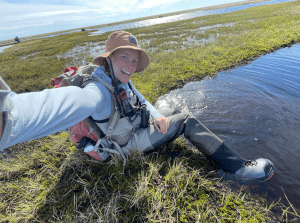Abigael Carron, Junior Biology and Environmental Studies major, shares about their internship with the US Fish and Wildlife Service in Utqiagvik, Alaska
 “When I said goodbye to my parents before hopping on my flight up to Alaska at the beginning of the summer, my last words were “I have no idea what I am about to get myself into, but this is going to be incredible.”
“When I said goodbye to my parents before hopping on my flight up to Alaska at the beginning of the summer, my last words were “I have no idea what I am about to get myself into, but this is going to be incredible.”
My name is Abigael Carron, and I am a rising senior majoring in Biology-Environmental Studies. This summer I had an opportunity to work as an assistant field technician with the US Fish and Wildlife Service (USFWS) in Utqiagvik, Alaska on their Stellers Eider project (Eiders are a type of sea duck!). This is a long-term research project that began in 1999 after Stellers Eiders were listed as Threatened under the Endangered Species Act in 1997.
While the project was initially focused on Stellers Eiders, it quickly  expanded to encompass Spectacled Eiders as well. Suitable nesting habitat for Eiders across the North Slope has been decreasing Alaska due to climate change and human development. In addition, Eiders are threatened by hunting and contaminants – specifically lead poisoning from lead bullets. King and Common Eider populations are currently stable, however the USFWS Eider Project includes King Eiders in the study as they nest within the Utqiagvik study region, but Common Eiders do not.
expanded to encompass Spectacled Eiders as well. Suitable nesting habitat for Eiders across the North Slope has been decreasing Alaska due to climate change and human development. In addition, Eiders are threatened by hunting and contaminants – specifically lead poisoning from lead bullets. King and Common Eider populations are currently stable, however the USFWS Eider Project includes King Eiders in the study as they nest within the Utqiagvik study region, but Common Eiders do not.
 In addition to studying Eiders this summer, our data collection was also heavily focused around two other species: Brown Lemmings and Pomarine Jaegers. Lemmings (a little tundra rodent) are a crucial food source to many animals such as Snowy Owls, Arctic Foxes, and Jaegers (another type of sea bird). If there is a low abundance of Lemmings one year (as there happened to be this year) it can affect the predation on nesting Eiders. Jaegers and Arctic Foxes will predate on Eider nests when Lemmings are not an abundant food source. Therefore, we like to keep track of the quantity and distribution of their population throughout the study site subplots. Pomarine Jaegers are extremely territorial when they nest and will defend a territory of about 200m around their nest. Jaegers will divebomb (sometimes making contact with their feet or wings) and “yell” at any intruder in
In addition to studying Eiders this summer, our data collection was also heavily focused around two other species: Brown Lemmings and Pomarine Jaegers. Lemmings (a little tundra rodent) are a crucial food source to many animals such as Snowy Owls, Arctic Foxes, and Jaegers (another type of sea bird). If there is a low abundance of Lemmings one year (as there happened to be this year) it can affect the predation on nesting Eiders. Jaegers and Arctic Foxes will predate on Eider nests when Lemmings are not an abundant food source. Therefore, we like to keep track of the quantity and distribution of their population throughout the study site subplots. Pomarine Jaegers are extremely territorial when they nest and will defend a territory of about 200m around their nest. Jaegers will divebomb (sometimes making contact with their feet or wings) and “yell” at any intruder in  order to scare them away. Therefore, many Eiders take advantage of this protection and nest near Pomarine Jaegers. This correlation is extremely interesting because most nests without a Pomarine Jaeger nearby will be destroyed by a fox, but the Eiders run the risk of a Jaeger eating one of their eggs if the Eider is not able to defend itself well enough.
order to scare them away. Therefore, many Eiders take advantage of this protection and nest near Pomarine Jaegers. This correlation is extremely interesting because most nests without a Pomarine Jaeger nearby will be destroyed by a fox, but the Eiders run the risk of a Jaeger eating one of their eggs if the Eider is not able to defend itself well enough.
I want to share a little bit more about where I was… Utqiagvik is a small arctic village in the northernmost part of Alaska (and the US). Throughout the summer I  was able to see polar bears, seals, caribou and even swim in the ocean! We attended Nalukataq (whaling festivals) and celebrated the success of whaling season with the local crews. I am extremely grateful for everyone in Utqiagvik who welcomed our USFWS crew into the community and shared their traditions, food, stories, language and much more.”
was able to see polar bears, seals, caribou and even swim in the ocean! We attended Nalukataq (whaling festivals) and celebrated the success of whaling season with the local crews. I am extremely grateful for everyone in Utqiagvik who welcomed our USFWS crew into the community and shared their traditions, food, stories, language and much more.”